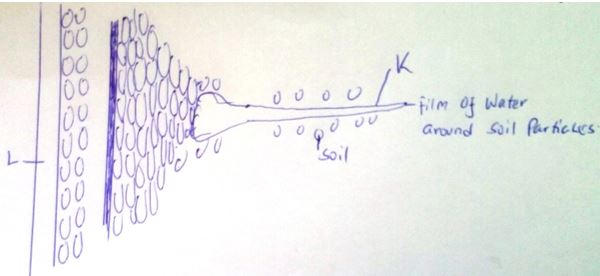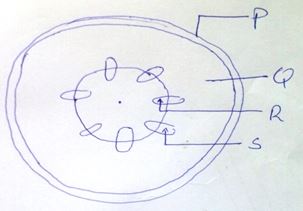Answer all the questions in the spaces provided.
- The diagram below represents these pathways of water from the soil into the plant.
- Name the structures labeled K and L. (2 mks)
- Explain how water from the soil reaches the structure labeled L. (5 mks)
- Name the process by which mineral salts enter into the plant. (1 mk)
- State four ways in which xylem vessels are adapted to their functions. (4 mks)
- Name two processes that bring about the translocation of manufactured food. (2 mks)
- Name three significance of transpiration. (3 mks)
- State three structural factors affection affecting the rate of transpiration in plants. (3 mks)
- The diagram below shows a cross section of a dicotyledonous plant. Use it to answer the questions that follow.
- Identify three parts labeled P, Q, R and S. (4 mks)
- State the functions of the parts labeled R and S. (3 mks)
- What is the function of carnassials teeth. (2 mks)
- Distinguish between the term homodont and heterodont. (3 mks)
- State two functions of bile juice in the digestion of food. (2 mks)
- Plant cell do not burst when immersed in distilled water. Explain. (2 mks)
- Describe what happens during the light stage of photosynthesis. (3 mks)
- State and explain three factors that affect enzymatic activities. (6 mks)
- State the functions of the following organelles:
- Ribosomes (1 mk)
- Lysosomes (1 mk)
- Name two dental diseases. (2 mks)
- Give three characteristics of a cell membrane. (3 mks)

Marking Scheme
- The diagram below represents these pathways of water from the soil into the plant.
- Name the structures labeled K and L. (2 mks)
- K= root hair reject hair root
- L= xylem vessel
- Explain how water from the soil reaches the structure labeled L. (5 mks)
- Water moves from the soil into the root hair by osmosis because the concentration of cell sap is higher than the water in the soil. The cell sap in the root hair is diluted thus making it less concentrated than the neighbouring cells. Therefore, water moves into the neighboring cells. It is an actively secreted into structure L.
- Name the process by which mineral salts enter into the plant. (1 mk)
- Active transport/diffusion
- Name the structures labeled K and L. (2 mks)
- State four ways in which xylem vessels are adapted to their functions. (4 mks)
- Lignified thickened to prevent collapsing(acc. Strengthening)
- Narrow to facilitate capillarity and strength
- Hollow for continuous column of water
- Have bordered pits to allow water to move to adjacent vessels
- Name two processes that bring about the translocation of manufactured food. (2 mks)
- Active transport
- Diffusion
- Mass flow
- Cytoplasmic streaming
- Name three significance of transpiration. (3 mks)
- Through the process mineral ions and water are transported in the plants
- It serves to cool the plants, especially in hot environments
- It helps in removal of excess water especially in aquatic plants
- It is responsible for turgor in plants
- State three structural factors affection affecting the rate of transpiration in plants. (3 mks)
- Cuticle
- Leaf size and shape
- Stomata
- Hairy leaves
- The diagram below shows a cross section of a dicotyledonous plant. Use it to answer the questions that follow.
- Identify three parts labeled P, Q, R and S. (4 mks)
- P= epidermis
- Q= cortex
- R= xylem
- S= phloem
- State the functions of the parts labeled R and S. (3 mks)
- R- transports water and mineral salts from the roots to all parts of the plant tissues/ cells.
- S- transports dissolved food substances or manufactured food from the leaves to all parts of the plant cell/tissues
- Identify three parts labeled P, Q, R and S. (4 mks)
- What is the function of carnassials teeth. (2 mks)
- Cutting, chopping, shearing, slicing and crushing
- Distinguish between the term homodont and heterodont. (3 mks)
- Homodont- having the same type/kind/ similar teeth
- Heterodont- having different types/kinds of teeth
- State two functions of bile juice in the digestion of food. (2 mks)
- Emulsification of fats, breaking into small droplets
- Neutralizing the acidity of chime; provides an alkaline media for enzyme
- Plant cell do not burst when immersed in distilled water. Explain. (2 mks)
- Plant cells have a membrane and a cell wall. When a cell is placed in distilled water, the water is absorbed through osmosis. As the cell becomes turgid, the cell creates an inward pressure (e.g. wall pressure) and turgor pressure which prevents the cell from bursting
- Describe what happens during the light stage of photosynthesis. (3 mks)
- Takes place in the grana of the chloroplast. Light is absorbed and used to split water molecules into hydrogen ions and oxygen, photolysis. Energy is formed and stored in form of ATP
- State and explain three factors that affect enzymatic activities. (6 mks)
- Temperature
- Very low temperatures inactive the enzymes. Very high temperatures denature the enzyme. Therefore optimum temperature should be maintained for maximum enzyme activity.
- pH value
- Some enzymes act best in acidic or basic medium. Therefore optimum pH should be maintained for maximum enzyme activity.
- Enzyme concentration-
- When enzyme concentration is increased, the rate of enzyme activity also increases as long as there are enough molecules of the substrate.
- Substrate concentration
- When the substrate concentration is increased, the rate of enzyme activity also increases as long as there are enough molecules of the enzymes. Further increase of the substrate may not increase the rate as all the active sites of the enzymes will be occupied
- Enzyme co-factor
- They are the non-proteineous substances that activate the enzymes. Most enzymes will not work without co-factors. They are metallic ions.
- Co-enzymes
- They are organic non-protein molecules that work in association with enzymes. They are derived from vitamins.
- Enzyme inhibitors
- They are substances that slow down or stop enzyme activity if present. They fit into the active site of the substrate hence the enzyme has no chance to fit into the active sites.
- Temperature
- State the functions of the following organelles:
- Ribosomes (1 mk)
- Site of protein synthesis
- Lysosomes (1 mk)
- Destroys old and worn out organelles
- Ribosomes (1 mk)
- Name two dental diseases. (2 mks)
- Periodontal diseases
- Dental cavities
- Give three characteristics of a cell membrane. (3 mks)
- Sensitive to pH
- Highly polarized
- Semi permeability (permeable)
Join our whatsapp group for latest updates
Tap Here to Download for 50/-
Get on WhatsApp for 50/-
Download Biology Questions and Answers - Form 2 Term 1 Opener Exams 2021.
Tap Here to Download for 50/-
Get on WhatsApp for 50/-
Why download?
- ✔ To read offline at any time.
- ✔ To Print at your convenience
- ✔ Share Easily with Friends / Students



